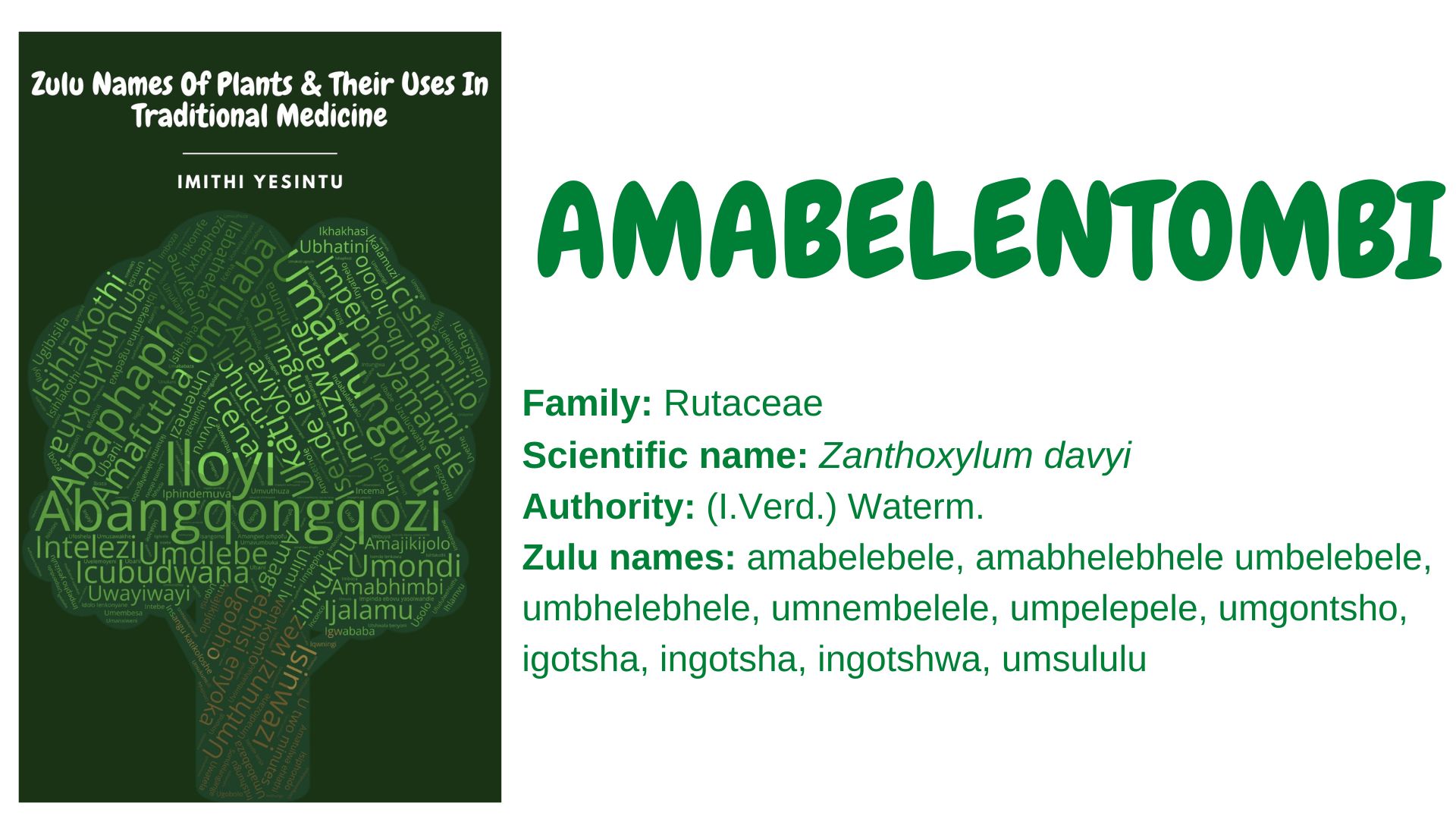Family: Rutaceae
Scientific name: Zanthoxylum davyi
Authority: (I.Verd.) Waterm.
Synonyms: Fagara davyi I.Verd., Zanthoxylum thunbergii DC.
Zulu names: isinungwane, isimungumabele, umlungumabele, umnungwane, umnungwane omkhulu, umnungumabele, umnungumabele omkhulu
Other names: fever tree, forest knobwood, knobwood (English), bos-perdepram, knopdoring, knopdoringhout, knoppiesdoring, perdepram, perdepramboom, paardepraam, wilde-kardemom, wildekarmonk (Afrikaans), monokwane, senokomaropa, senoko-maropa, senokumarupa (North Sotho), munungu, murandela (Venda)
Plant description: Z. davyi is a tree with compound broad leaves, small greenish yellow flowers in clusters, globose fruits containing one black and shiny seed, and knobs on the stem. The tree is native in Southern Africa and occurs along the coastal forests.
Uses:
- The bark is used to make umuthi obovu that is administered as an emetic.
- The bark is used to make umuthi omhlophe that is administered by steaming.
- The bark is used as an ingredient in a tonic called uzifozonke taken as a general herbal tonic.
- The plant (bark) is used to treat ilumbo.
- The bark and root is used to remove a troublesome tooth. The powdered bark is administered by gargling. The powdered bark is inserted into the tooth cavity. The powdered roots are used to relieve toothache.
- The bark is used to treat boils. The bark is charred and applied onto the boil opening. The bark is boiled and the decoction administered as an enema.
- The bark is boiled or chewed to treat chronic cough, cold, chest pains, bronchitis, and pleurisy.
- The powdered bark is cooked with meat or the powdered bark is licked to treat meat allergies.
- The bark is used to make a tonic that is administered as enema to treat and remove warts.
- This plant is used to treat parasitic worms.
- The roots are used to make a tonic to treat fits.
- The roots are used to treat blisters, wounds, sore, and ulcers. The leaves are used to make a poultice to heal sores.
- The roots are used to treat stomach cramps and venereal diseases.
- The plant is used to treat snake bites.
- The roots are tonic and aphrodisiac.
- The wood is used to make handles, fishing rods, toys, musical instruments, and walking sticks.
- The wood is used for construction and furniture.
Safety precaution:
Using traditional medicine responsibly can enhance your overall health and well-being. Misuse and abuse can lead to complications. You can inquire about the correct use of traditional medicine from a knowledgeable herbalist and practitioner. You can also visit imithiyesintu.co.za or email: info@imithiyesintu.co.za to learn more about traditional medicine
References and further reading:
- Boon, R., 2010. Pooley’s trees of eastern of South Africa: A complete guide, second edition. Flora and Fauna Publications, Durban.
- Cunningham, A.B., 1988. An investigation of the herbal medicine trade in KwaZulu Natal. Institute of Natural.
- Hutchings, A., Scott, A.H., Lewis, G., and Cunningham, A.B., 1996. Zulu Medicinal Plants. An inventory. University of Natal Press, Pietermaritzburg.
- Kelmanson, J.E., Jäger, A.K. and van Staden, J., 2000. Zulu medicinal plants with antibacterial activity. Journal of ethnopharmacology, 69(3), pp.241-246.
- Mabogo., D.E.N., 1990. The ethnobotany of the VhaVenda. M.Sc. dissertation, University of Pretoria, Pretoria.
- Maroyi, A., 2011. An ethnobotanical survey of medicinal plants used by the people in Nhema communal area, Zimbabwe. Journal of Ethnopharmacology 136, pp. 347–354.
- Ngwenya, M.A., Koopman, A., Williams, R., 2004. Zulu botanical knowledge – an introduction (Ulwazi lwamaZulu ngezimila: isingeniso). National Botanical Institute, Durban.
- Obi, C.L., Potgieter, N., Randima, L.P., Mavhungu, N.J., Musie, E., Bessong, P.O., Mabogo, D.E.N. and Mashimbye, J., 2002. Antibacterial activities of five plants against some medically significant human bacteria: research in action. South African journal of science, 98(1), pp.25-28.
- Resources Investigative Report Issue 29. Institute of Natural Resources, Pietermaritzburg.
- Watt, J. M. and Breyer-Brandwijk, M. G. 1932. The medicinal and poisonous plants of southern Africa, 1st edn. Livingstone, London.
You Can Order Your Copy Of The Book By Emailing: info@imithiyesintu.co.za
Feel Free To Add Other Uses Of This Plant In The Comment Section Below:

